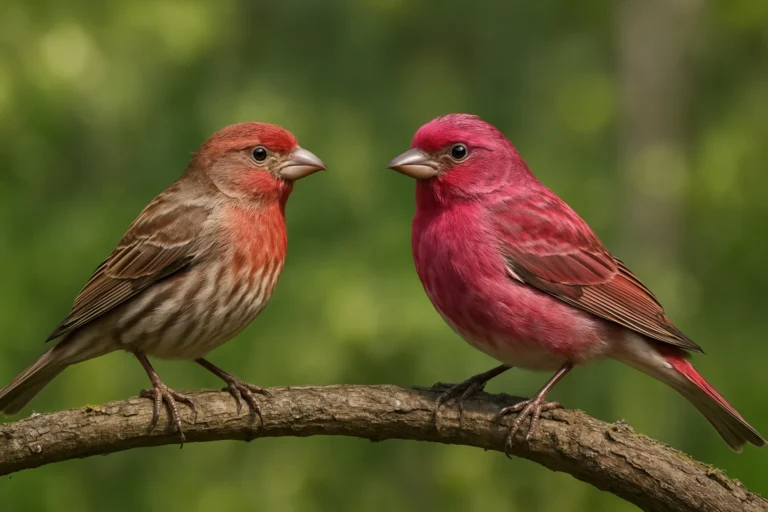Preparing to step into the fascinating world of birds? Then, you must be ready to see these little creatures show some amazing or quirky behaviors. From chirping loudly in the morning to singing melodious songs and mimicking human sounds, they show a range of impressive traits. You will be surprised to learn that these actions are not just random expressions. Rather, they serve different purposes, such as communicating, attracting mates, warning of danger, or even reflecting emotions.
In short, their world is full of surprises. You will always find them tickling your curiosity all along your birdwatching or birding journey. That is why understanding these traits is an essential part of becoming a true bird hobbyist.
This article will explore nine fascinating bird behaviors and what they really mean. So, sit tight, say goodbye to distractions, and read this guide to the end to gain deeper insights.
1. Chirping in the Morning
Sometimes, we wake up early in the morning to the loud but beautiful sounds of our avian friends. For years, it has been a sort of mystery why birds chirp in the morning. Today, however, we have a few satisfying answers. Some studies show that it is an effort to warm up their voices for the rest of the day. For instance, American robins and Northern cardinals chirp slowly before building up to their full voices.
Another prime reason for this amusing trait is marking their territories and letting other avians know they are around. Song sparrows and Eurasian blackbirds are well-known for exhibiting this behavior. On the other hand, birds like the common nightingale and the Eastern bluebird want to make their mornings more romantic by singing beautifully to attract mates.
2. Singing to Impress
It is probably one of the cutest behaviors of these little creatures. See, if you think birds sing just for fun, you might be wrong. They often use their songs to impress the opposite gender. It is a method male birds use to showcase their strength and health. The nightingale, for example, is well-known for its melodious and complex songs to win over a female. Similarly, lyrebirds copy other avians and environmental sounds to sway potential mates.
However, impressing someone is also not the only reason. There are some birds that use singing as a means to defend their territories. The American robin and blackbirds sing to warn other birds to stay away. A strong, confident voice tells rivals that the area is already claimed. Whether for love or defense, this is a remarkable and valuable skill that helps avians survive and succeed in the wild.
3. Mimicking Sounds
Some birds have this great ability to mimic other species. You must already know about parrots that are well-known imitators. These widely-loved avians can imitate human speech, laughter, and even doorbells with remarkable accuracy. But they are not the only feathered creatures with this amazing gift. The Northern mockingbird, for instance, impersonates sounds of other birds, car alarms, and even musical instruments.
Lyrebird is famous for mimicking odd objects like chainsaws, dogs barking, and camera shutters. The question is what is the reason behind showing this behavior. The prime objectives include learning and adapting, attracting mates, socializing, or even camouflaging. Mockingbirds, such as, imitate other birds’ sounds to keep intruders away from their territories.
4. Seeing at Night
Some birds are nocturnal animals, and to adapt to this lifestyle, nature has blessed them with a remarkable capability to see in the dark. Owls are the best example. With their big eyes, they can spot tiny movements even in pitch black. They also showcase another remarkable trait. As their eyes cannot move like ours, they turn their heads almost all the way around to see what’s going on. This makes them excellent nighttime hunters.
Owls, though, share this capability with some other avians. Tawny frogmouths also have great night vision, allowing them to spot insects and small prey in low light. Night herons are another example. They hunt for fish in the dark using their sharp eyesight to detect movement in the water. These birds prove that not all creatures need daylight to survive.
5. Flying in Flocks
You must have witnessed one of the most beautiful scenes in the sky, and we are talking about large flocks of birds flying in precisely coordinated and fluid motion. Sticking together helps these creatures evade predators because they become challenging to spot. Starlings, for example, create huge swirling patterns in the sky called murmuration, confusing hawks and other hunters.
Geese, on the flip side, fly in an attractive V-shape manner. It is a perfectly systematic approach with the front bird breaking the wind while the others get an easier ride. Protection, however, is not the only reason to fly in flocks. It also makes finding food and staying on course feasible. This can be seen in flamingos that travel in large numbers to find water.
6. Mating Displays
The mating displays of some avians are truly mesmerizing. They use various strategies to impress and catch the attention of mates. Peacocks, say, fan out their big, colorful tail feathers and shake them to catch a female’s attention. Bigger and brighter feathers mean better chances of winning a companion. Birds of paradise take things even further.
They perform fancy dances, hang upside down, and even puff up their feathers to put on a show. Not all winged creatures rely solely on their looks, though. Songbirds, like nightingales and canaries, sing beautiful songs to attract a partner. The louder and more complex the song, the more likely they are to impress a female. No matter the method, these displays help birds find the perfect match.
7. Building Nests
You already know that birds build nests. However, it is not just about having a home. It is a tremendous skill that helps them survive in the wild. Avian creatures can be wise, smart, and expert builders. Weaver birds, for example, carefully weave grass and twigs to create sturdy, hanging nests. Robins, on the other hand, use mud and other soft materials to keep their nest cozy and simple.
Here is another interesting thing about this bird behavior. Not all follow the same nesting rules. Cuckoos take the easy way out by laying their eggs in other birds’ nests, tricking them into raising their young. Penguins, on the contrary, skip nests altogether and build little piles of rocks to keep their eggs safe.
8. Preening Feathers
It is one of the most perplexing behaviors that some birds exhibit. These fascinating creatures spend a lot of time preening their feathers. It is a way of keeping their feathers clean and in good shape. They use their beaks to remove dirt and spread natural oils to make them waterproof. Parrots and pigeons are often seen carefully grooming themselves to stay neat and healthy.
So, is preening that crucial? Yes, without it, their feathers could get messy, making it harder to fly or stay warm. Some can even help each other for this reason. Preening together builds trust and credibility, strengthening bonds between them. Lovebirds, such as, gently groom their partners as a way to show care.
9. Play for Fun
Birds are not confined to eating, flying, mating, and surviving. They also play for entertainment. Have you ever seen a crow drop a stick in the air only to catch it a moment after? It does not mean that the bird has accidentally dropped the object. Rather, it is a game that crows love to play. Like parrots enjoy rolling balls, swinging on branches, or even engaging in tug-of-war.
Some birds even play in groups. Swallows chase each other in the sky just for the thrill of it, while magpies have been seen sliding down snowy rooftops like little sledders. This playful behavior shows that birds are just like us. They also love enjoying their lives, having fun, and exploring the world around them.
Conclusion
Our avian friends show a range of behavior due to evolutionary adaptations. These traits assist them in surviving, communicating, and reproducing. Chirping and singing is a method to attract mates. Building nests and flying in flocks is a survival mechanism. Preening keeps their feathers clean. In short, each expression in the world of birds has a meaning and understanding this is necessary to become an expert bird hobbyist. Stay in touch to learn more about the colorful world of our feathered friends.


